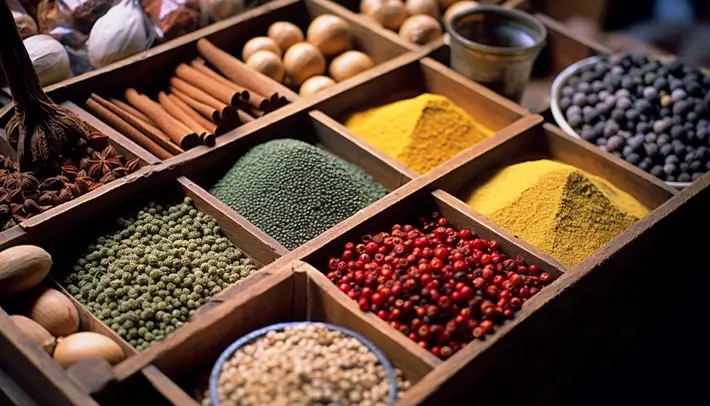A Beginner’s Guide to Exploring the World of Indian Spices

Indian cuisine is known for its bold flavours and use of aromatic spices. Whether you’re a seasoned cook or a novice in the kitchen, exploring the world of Indian spices can be a fun and rewarding experience. The use of spices in Indian cooking dates back thousands of years and is deeply ingrained in the culture and traditions of the country.
In this article, we will take a closer look at the world of Indian spices and how they are used in cooking. From the common spices used in Indian cuisine to the health benefits associated with their consumption, we’ll explore everything you need to know to get started with cooking Indian food.
So, whether you’re looking to expand your culinary repertoire or simply add some new flavours to your cooking, this beginner’s guide to Indian spices is the perfect place to start. Consider going back to a classic recipe to put all these tips into practice, for example, with a dish of Spanish rice (find that recipe here: successrice.com/recipes/spanish-rice/). Let’s dive in!
Common Indian Spices
Indian cuisine is renowned for its use of a variety of spices, each with its own unique flavour and aroma. Here are some of the most commonly used spices in Indian cooking:
1. Cumin: This spice is characterized by its earthy and nutty flavour, with a hint of sweetness. Cumin is commonly used in Indian curries, soups, and stews, and is a staple in many spice blends.
2. Coriander: Coriander has a citrusy and slightly sweet flavour, with a hint of earthiness. It is commonly used in Indian chutneys, marinades, and spice blends.
3. Turmeric: This bright yellow spice has a warm, slightly bitter flavour with a subtle hint of ginger. Turmeric is commonly used in Indian curries and rice dishes, and is known for its anti-inflammatory properties.
4. Cardamom: This sweet and fragrant spice has a complex flavour that is both spicy and floral. Cardamom is commonly used in Indian desserts, as well as savory dishes such as biryanis and curries.
5. Cinnamon: Cinnamon has a warm and sweet flavour, with a hint of spiciness. It is commonly used in Indian desserts and rice dishes, as well as spice blends for savory dishes.
6. Mustard seeds: These tiny seeds have a pungent, nutty flavour with a hint of bitterness. Mustard seeds are commonly used in Indian pickles, chutneys, and spice blends.
7. Garam masala: This spice blend is a staple in Indian cuisine and typically includes a mix of cinnamon, cardamom, cloves, cumin, and coriander. Garam masala is commonly used in curries and other savory dishes, and can also be sprinkled on top of dishes for added flavour.
When cooking with Indian spices, it’s important to consider the flavour profile of each spice and how it can be used to create a well-balanced dish. By understanding the characteristics of each spice, you can experiment with different combinations and create your own unique blends for your favourite Indian dishes.
How to Buy and Store Indian Spices
Buying and storing spices is crucial to maintaining their freshness and flavour. Here are some tips to help you get the most out of your Indian spices:
8. Buy whole spices: Whole spices retain their flavour and aroma for longer than ground spices. When possible, buy whole spices and grind them yourself just before using them in your dishes.
9. Look for quality: When buying Indian spices, look for high-quality products that are fresh and aromatic. Choose spices that have a vibrant colour and a strong aroma.
10. Buy in small quantities: Indian spices are best used fresh, so it’s important to buy them in small quantities to ensure that you use them up before they lose their flavour.
11. Store in airtight containers: To keep your spices fresh, store them in airtight containers in a cool, dry place away from sunlight. This will help to prevent moisture and oxidation, which can cause the spices to lose their flavour.
12. Label your spices: When storing multiple spices, it’s important to label them with their name and the date of purchase to avoid confusion and ensure that you use them up while they are still fresh.
By following these simple tips, you can ensure that your Indian spices stay fresh and flavourful, and that you get the most out of your culinary explorations. So go ahead, stock up on some high-quality Indian spices, and let your taste buds take a trip to the colourful and aromatic world of Indian cuisine!
Using Indian Spices in Cooking
Now that you’ve learned about the most common Indian spices and how to buy and store them, it’s time to explore how to use these flavourful ingredients in your cooking. Indian spices are known for their ability to add depth and complexity to dishes, and with a little bit of know-how, you can create dishes that burst with flavour.
13. Balancing Flavours: When cooking with Indian spices, it’s important to balance the different flavours to create a harmonious dish. Indian cuisine typically balances spicy, sour, sweet, and savory flavours. Experiment with the different spices and keep in mind that a little bit goes a long way.
14. Creating Complex Dishes: Indian cuisine is known for its complex, layered flavours. To achieve this, start with a base of spices and then build upon it with other ingredients such as vegetables, meat, or rice. Don’t be afraid to get creative and try new combinations of spices and ingredients.
Example Recipes:
• Chana Masala: This classic vegetarian dish features chickpeas cooked in a spicy tomato-based sauce, flavoured with cumin, coriander, turmeric, and garam masala.
• Butter Chicken: This creamy and flavourful chicken dish is a popular Indian restaurant favourite. The chicken is marinated in a mixture of spices, yogurt, and lemon juice, then simmered in a sauce made with tomato puree, cream, and a blend of spices including garam masala and fenugreek.
• Samosas: These crispy and savory pastries are a popular street food in India. They are typically filled with spiced potatoes and peas, flavoured with cumin, coriander, and garam masala.










